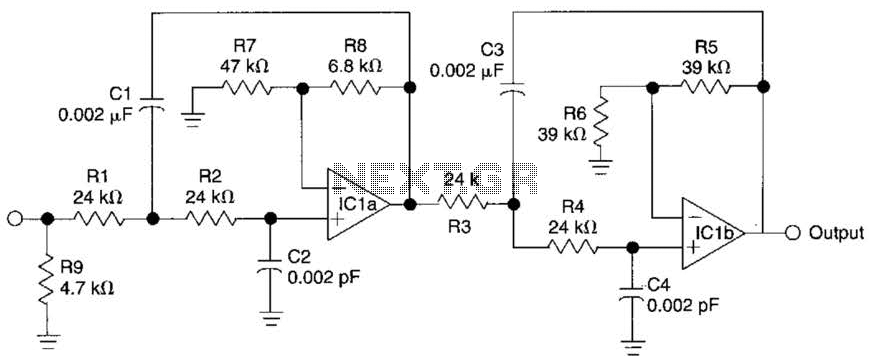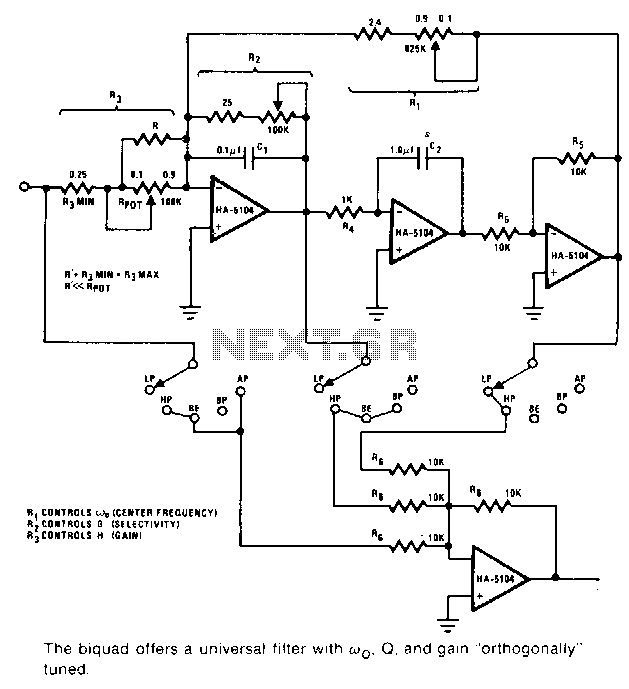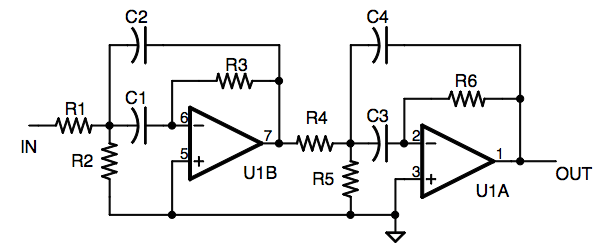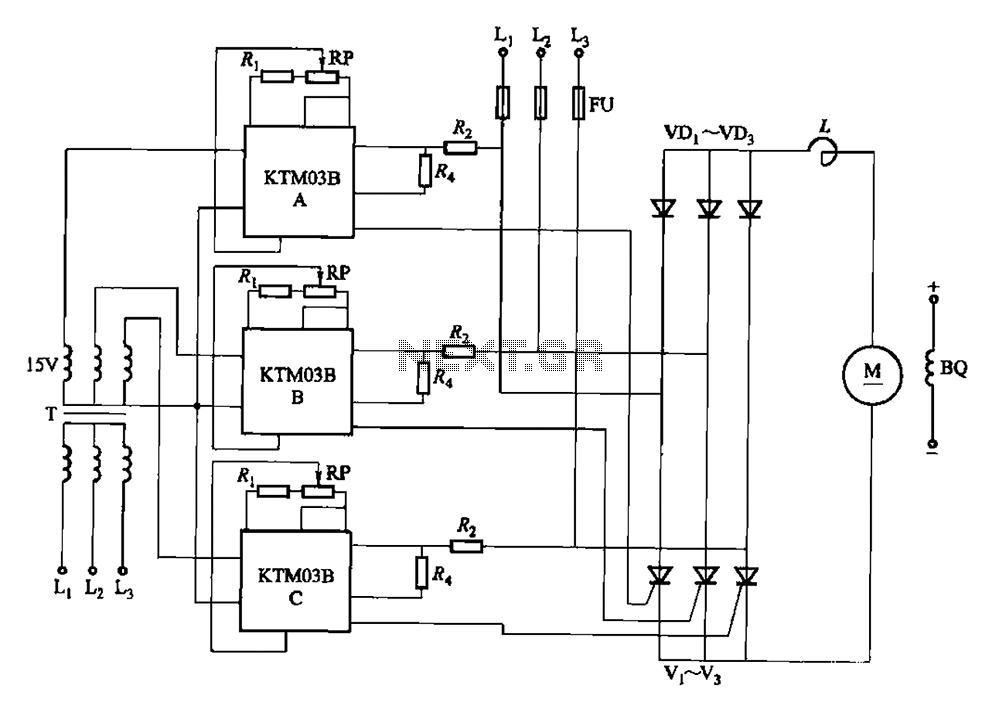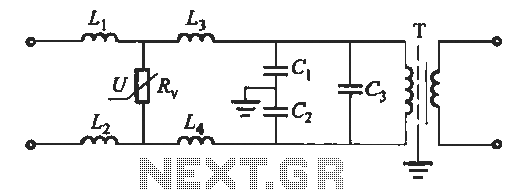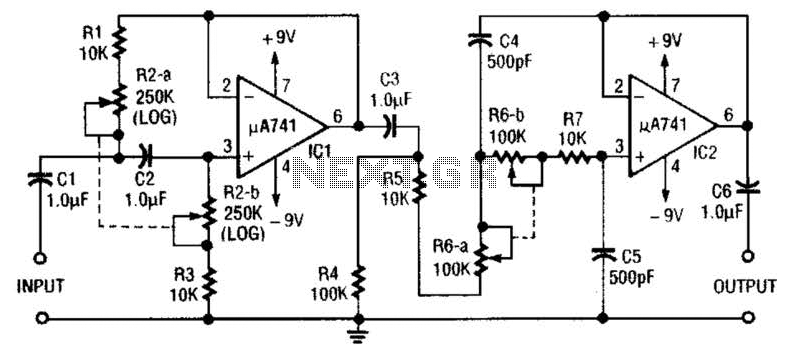
The Full-Wave Rectifier and Averaging Filter
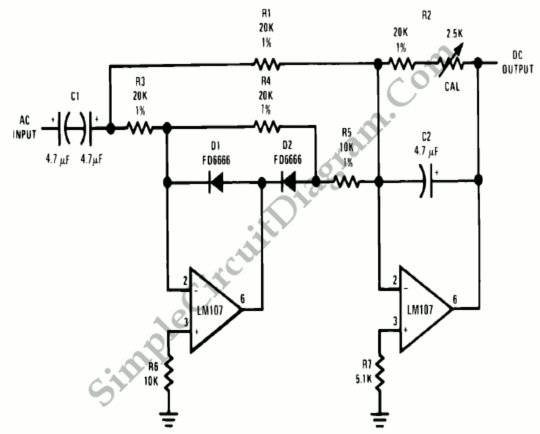
The core of a typical RMS calibrated AC voltmeter consists of a rectifier and averaging filter. To create a precision full-wave rectifier, the averaging function can be removed by eliminating capacitor C2, while deleting capacitor C1 will enable the circuit to function as an absolute value generator. Understanding the circuit operation involves tracing the signal path for both negative and positive inputs. The output of amplifier A1 is clamped to +0.7V by diode D1, which disconnects it from the summing point of amplifier A2 via diode D2 for negative signals. Consequently, A2 operates as a simple unity gain inverter with input resistor R1 and feedback resistor R2, resulting in a positive-going output. For positive inputs, A1 functions as a standard amplifier connected to the A2 summing point through resistor R5. In this configuration, the amplifier behaves as a unity gain inverter with input resistor R3 and feedback resistor R5. The presence of D2 does not affect the gain accuracy of A1, as it is within the feedback loop. Negative current is drawn from the A2 summing point through resistor R5, while positive current enters through resistor R1. The net input current at the A2 summing point equals the opposite of the current through R1, allowing amplifier A2 to act as a summing inverter with unity gain. This results in a positive output since the voltages across R1 and R5 are equal and opposite, with R5 being half the value of R1. If the circuit is intended to serve as an absolute value generator, the removal of capacitor C1 will yield the positive absolute value of the input voltage. For unity gain operation, the amplifiers must be compensated, and resistors R6 and R7 should be selected to minimize output errors caused by input offset current.
The described circuit operates effectively as a precision AC voltmeter by utilizing a combination of rectification and amplification techniques. The full-wave rectification process is achieved through the arrangement of diodes and amplifiers, ensuring that both positive and negative input signals are accurately processed. The clamping action of diode D1 is crucial in maintaining the output voltage within a specified range, preventing distortion of the signal during negative cycles.
In the positive input scenario, the operation of amplifier A1 as a standard amplifier allows for the accurate amplification of the signal before it reaches the summing point of A2. The configuration of resistors R1 and R2 ensures that A2 functions as a unity gain inverter, effectively flipping the phase of the input signal while maintaining its magnitude. This is critical for accurately representing the RMS value of the AC input.
When examining the negative input path, the role of diode D2 becomes apparent as it isolates the output of A1 from A2, allowing the circuit to handle negative voltages without affecting the overall operation. The feedback loop involving resistors R3 and R5 is designed to maintain stability and accuracy, ensuring that the gain of A1 remains unaffected by variations in the input signal.
For applications requiring absolute value generation, the removal of capacitor C1 simplifies the circuit while still providing a reliable output. This modification is particularly useful in scenarios where only the magnitude of the AC voltage is of interest, eliminating the need to consider the sign of the input signal.
Overall, the careful selection of components and configuration of the circuit elements contribute to the reliability and accuracy of the AC voltmeter, making it suitable for various measurement applications in electronics.The heart of an average reading, rms calibrated AC voltmeter is shown in figure below. It`s a rectifier and averaging filter. We can remove the averaging function and provide a precision full-wave rectifier by deleting C2 and provide an absolute value generator by deleting C1. By following the signal path for negative and then for positive input, circuit operation may be understood. The output of amplifier A1 is clamped to +0. 7V by D1 and disconnected from the summing point of A2 by D2 for negative signals. A2 then will be behave as a simple unity gain inverter with input resistor, R1, and feedback resistor, R2. This will give positive going output. A1 operates as a normal amplifier connected to the A2 summing point through resistor R5 for positive inputs.
Then amplifier will behave as a simple unity gain inverter with input resistor R3 and feedback resistor R5. Since it is inside the feedback loop, A1 gain accuracy is not affected by D2. Negative current is drawn from A2 summing point through resistor R5 and positive current enters the A2 summing point through resistor R1.
The net input current at the A2 summing point is equal to and opposite from the current through R1 and amplifier A2 operates as a summing inverter with unity gain, again giving a positive input since the voltages across R1 and R5 are equal and opposite, and R5 is one half the value of R1. If the circuit is to used as an absolute value generator, capacitor C1 may be deleted. The circuit output will be the positive absolute value of the input voltage when this is done. For unity gain operation, the amplifiers chosen must be compensated. R6 and R7 must be selected to minimize output errors due to input offset current. [Source: National Semiconductor Application Note ] 🔗 External reference
The described circuit operates effectively as a precision AC voltmeter by utilizing a combination of rectification and amplification techniques. The full-wave rectification process is achieved through the arrangement of diodes and amplifiers, ensuring that both positive and negative input signals are accurately processed. The clamping action of diode D1 is crucial in maintaining the output voltage within a specified range, preventing distortion of the signal during negative cycles.
In the positive input scenario, the operation of amplifier A1 as a standard amplifier allows for the accurate amplification of the signal before it reaches the summing point of A2. The configuration of resistors R1 and R2 ensures that A2 functions as a unity gain inverter, effectively flipping the phase of the input signal while maintaining its magnitude. This is critical for accurately representing the RMS value of the AC input.
When examining the negative input path, the role of diode D2 becomes apparent as it isolates the output of A1 from A2, allowing the circuit to handle negative voltages without affecting the overall operation. The feedback loop involving resistors R3 and R5 is designed to maintain stability and accuracy, ensuring that the gain of A1 remains unaffected by variations in the input signal.
For applications requiring absolute value generation, the removal of capacitor C1 simplifies the circuit while still providing a reliable output. This modification is particularly useful in scenarios where only the magnitude of the AC voltage is of interest, eliminating the need to consider the sign of the input signal.
Overall, the careful selection of components and configuration of the circuit elements contribute to the reliability and accuracy of the AC voltmeter, making it suitable for various measurement applications in electronics.The heart of an average reading, rms calibrated AC voltmeter is shown in figure below. It`s a rectifier and averaging filter. We can remove the averaging function and provide a precision full-wave rectifier by deleting C2 and provide an absolute value generator by deleting C1. By following the signal path for negative and then for positive input, circuit operation may be understood. The output of amplifier A1 is clamped to +0. 7V by D1 and disconnected from the summing point of A2 by D2 for negative signals. A2 then will be behave as a simple unity gain inverter with input resistor, R1, and feedback resistor, R2. This will give positive going output. A1 operates as a normal amplifier connected to the A2 summing point through resistor R5 for positive inputs.
Then amplifier will behave as a simple unity gain inverter with input resistor R3 and feedback resistor R5. Since it is inside the feedback loop, A1 gain accuracy is not affected by D2. Negative current is drawn from A2 summing point through resistor R5 and positive current enters the A2 summing point through resistor R1.
The net input current at the A2 summing point is equal to and opposite from the current through R1 and amplifier A2 operates as a summing inverter with unity gain, again giving a positive input since the voltages across R1 and R5 are equal and opposite, and R5 is one half the value of R1. If the circuit is to used as an absolute value generator, capacitor C1 may be deleted. The circuit output will be the positive absolute value of the input voltage when this is done. For unity gain operation, the amplifiers chosen must be compensated. R6 and R7 must be selected to minimize output errors due to input offset current. [Source: National Semiconductor Application Note ] 🔗 External reference
